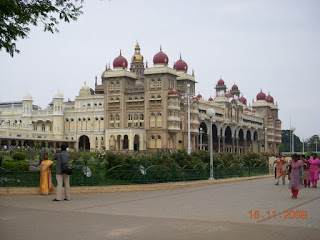


My earliest memories of Mysore evoke sugarcane fields whizzing past and the hot scent of rexine as our Ambassador taxi seats baked gently in the hot summer sun. Summer holidays spent in rural Chamarajanagar meant being a stone’s throw away from this historic city, and ensured at least one day following the Mysore trail…a peek at royalty at the ridiculously opulent palace, looking up in hushed awe at Rembrandt paintings in the huge echoing museum, getting scared out of our wits by the huge African elephants that towered over us at the zoo, and of course, what childhood memory is complete without a cool bite of chocolate ice-cream at Dasprakash!
I look back with indulgent nostalgia, young urban sophisticate that I now supposedly am. Going back after 15 years, my cynical city-cluttered mind whispered, that free of my childish naiveté, I would see things as they actually were: the palace seedy and overcrowded, the museum sadly dilapidated, and the zoo animals underfed and hag ridden. True, my perspective has changed. But as an ‘I told you so’ niggled at the back of my head, to my surprise I found myself all set to protect and defend! I wonder if it was my nascent patriotism or just a dawning realization and attachment to the very Indianness of it all…bottomline: I was still awed by the palace, although with an admixture of fond amusement at the frantically baroque façade. The caged animals at the zoo now evoked an uncomfortable lump of pity, guilt and anger, but I also took in the sleek coats of the tigers with gambolling cubs beside them, the huge airy enclosures, the newly tarred roads, the battery operated cars and the attempts at prettiness with flowered pathways, and felt an honest appreciation. The ‘I told you so’ retreated, for now.
History permeates the very air in Mysore, and as we drove past huge century old colonial-style government offices and the ubiquitous statues of erstwhile maharajas, I felt impossibly young and impermanent. The shadow of Tipu Sultan looms large over the city, and the wealth of monuments, paintings and artefacts left behind stand witness to his power and glory. Dariya daulat it says at the entrance, wealth of the sea: a wide-corridored, cool teakwood palace with tipu sultan’s glorious victories immortalized by frescoes adorning every available wall space. A few of the names on the walls rang a bell after William Dalrymple’s White Mughals, and for a few moments, those mere names came to life in the throes of battle. The lovingly tended mughal-style bagh of the summer palace spread out all around, and shaded by the huge trees and twittering birds, you could almost place yourself 400 years in the past. Tipu is buried not far from here, at the Gumbaz. It somehow felt far from being a melancholic reflection of death seen in other historic tombs. The tiger-patterned dome celebrated the Tiger of Mysore and there was always a handy guide willing to extol his virtues and victories for a quick buck.
I left with my head abuzz with names and dates, like it used to be a half hour before a history exam! Fancying myself a newly minted scholar in history and indo-saracenic architecture, we took the long road home…hopefully, a little less of a cynic!
I look back with indulgent nostalgia, young urban sophisticate that I now supposedly am. Going back after 15 years, my cynical city-cluttered mind whispered, that free of my childish naiveté, I would see things as they actually were: the palace seedy and overcrowded, the museum sadly dilapidated, and the zoo animals underfed and hag ridden. True, my perspective has changed. But as an ‘I told you so’ niggled at the back of my head, to my surprise I found myself all set to protect and defend! I wonder if it was my nascent patriotism or just a dawning realization and attachment to the very Indianness of it all…bottomline: I was still awed by the palace, although with an admixture of fond amusement at the frantically baroque façade. The caged animals at the zoo now evoked an uncomfortable lump of pity, guilt and anger, but I also took in the sleek coats of the tigers with gambolling cubs beside them, the huge airy enclosures, the newly tarred roads, the battery operated cars and the attempts at prettiness with flowered pathways, and felt an honest appreciation. The ‘I told you so’ retreated, for now.
History permeates the very air in Mysore, and as we drove past huge century old colonial-style government offices and the ubiquitous statues of erstwhile maharajas, I felt impossibly young and impermanent. The shadow of Tipu Sultan looms large over the city, and the wealth of monuments, paintings and artefacts left behind stand witness to his power and glory. Dariya daulat it says at the entrance, wealth of the sea: a wide-corridored, cool teakwood palace with tipu sultan’s glorious victories immortalized by frescoes adorning every available wall space. A few of the names on the walls rang a bell after William Dalrymple’s White Mughals, and for a few moments, those mere names came to life in the throes of battle. The lovingly tended mughal-style bagh of the summer palace spread out all around, and shaded by the huge trees and twittering birds, you could almost place yourself 400 years in the past. Tipu is buried not far from here, at the Gumbaz. It somehow felt far from being a melancholic reflection of death seen in other historic tombs. The tiger-patterned dome celebrated the Tiger of Mysore and there was always a handy guide willing to extol his virtues and victories for a quick buck.
I left with my head abuzz with names and dates, like it used to be a half hour before a history exam! Fancying myself a newly minted scholar in history and indo-saracenic architecture, we took the long road home…hopefully, a little less of a cynic!
